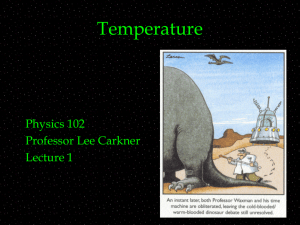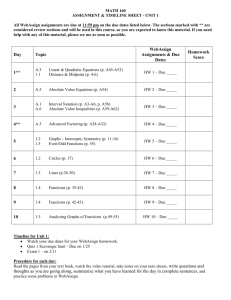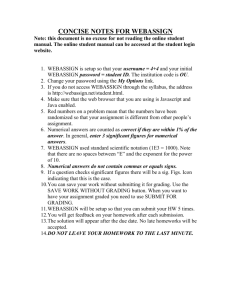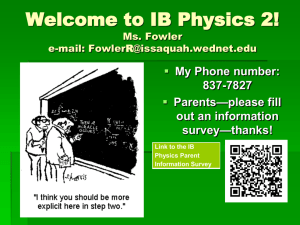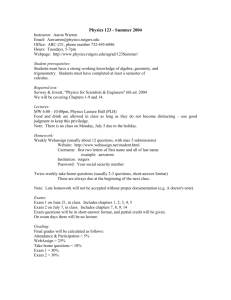A Brief History of Planetary Science
advertisement
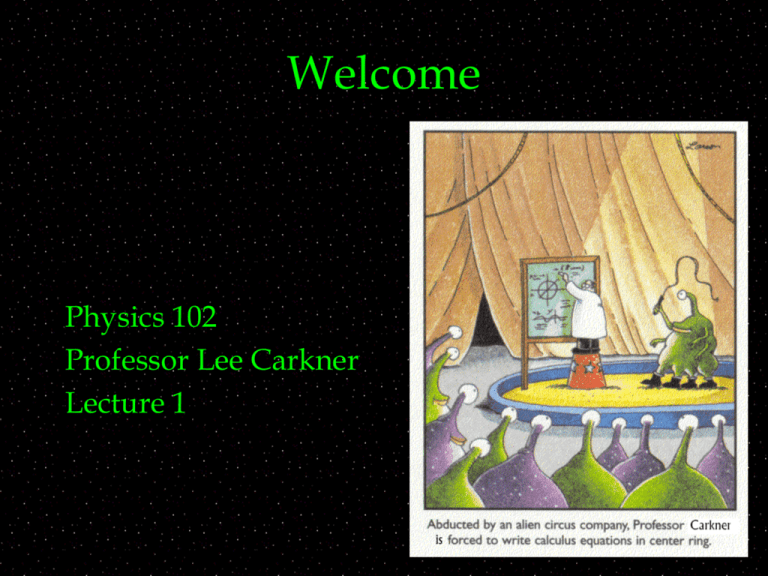
Welcome Physics 102 Professor Lee Carkner Lecture 1 Questions to Consider Am I in the right place? Physics 102: Principles of Physics Do I have the right stuff? James Walker, “Physics” Lab manual Calculator WebAssign card available at register at Runestone Bookstore Things to Know Professor Dr. Lee Carkner Office Hours MWF 10-11am Science 208 Help session: TBA Lab section See me after class to change How Does the Class Work? Read the book material before class Do the WebAssign homework Come to class Do the PAL discussion questions Lab once a week Two tests and final Web Page http://helios.augustana.edu/~lc/ph102 Outline gives homework and readings Lectures posted online before class Syllabus and WebAssign guide also posted Grading Two tests -- 30% Final -- 25% Homework -- 15% PAL -- 10% Lab -- 20% WebAssign Homework will be entered and graded online At webassign.com Click on student login Username is your first and last name together (e.g. “johnsmith”) Institution is “augustana” Password is same as last semester Augustana ID number if new to class After login, click on the current assignment and complete it WARNING: Can only submit it twice If you are new to Webassign read tutorial on class web page Homework Homework will generally be from book Will be posted on webpage WebAssign will randomize numbers Available at noon M,W,F Due at midnight M,W,F Cannot turn homework in late or make up Can drop lowest three Each homework worth same amount (100 points) 15% of grade PAL What is PAL? Physics Active Learning Each class you will get a PAL worksheet Contains questions about the material and feedback opportunities Worth 10% of your grade Need to come to class Can drop (or skip) three PAL’s “Physics is your PAL!” Guidelines for Work Handed In Written answers must be in complete sentences Numbers must have units Answers must reasonable If not reasonable, explain why All work must be neat and easily readable Today’s PAL Please answer the first questions: What is Physics? What are my goals in taking Physics? Feedback: Please list: Your major The highest level of math you have taken (Algebra, geometry, trig, pre-calc, calc) Comments Answers What is Physics? Phys"ics (?), n. The science of nature, or of natural objects; that branch of science which treats of the laws and properties of matter, and the forces acting upon it; especially, that department of natural science which treats of the causes (as gravitation, heat, light, magnetism, electricity, etc.) that modify the general properties of bodies; natural philosophy. --Webster’s Dictionary 1913 What is Physics? Physics is a way of figuring out how things work More specifically: what are the underlying rules that govern how things work? We will deal mostly with classical physics: i.e. How did things work before 1900? Why Take Physics? You may need to know how things work You can learn how to: Use reason and logic Solve problems Use mathematics It is useful to understand how we know how things work Thermodynamics What is thermodynamics? Thermo Involves temperature Dynamics Involves mechanics Thermodynamics is the study of thermal and mechanical energy How do you transform one into the other? Where Does Thermodynamics Come From? Back in the early 1800’s people figured out that you can transform thermal into mechanical energy Can make a device that turns heat into work A heat engine Problem: sometimes the engine would turn heat into horrible bodily injury Need to understand what is going on in the engine What is this Stuff? Liquid Nitrogen The liquid form of the nitrogen gas that makes up air Temperature = 77 Kelvin = -320 F LN will cause frostburn on contact What is it doing? Boiling Changing phase from liquid to gas Principles of Thermal Physics Lets think about the first five key variables in thermodynamics: Heat Work Temperature Pressure Volume The Pringles Launcher: A Simple Heat Engine For the Pringle’s launcher: How does the P,V and T of the material inside the can change? Describe the heat flow How could you measure the work? LN and Thermodynamics Using LN demonstrates how things are affected by temperature changes The properties of common objects depend on temperature The surface of the Earth is at a very special temperature (~0 Celsius) Most of the universe is not Our common sense about how things works only applies to a little corner of the universe Low Temperature Physics How is heat transformed into energy? Heat will expand a gas which in turn can do work How does temperature effect molecular bonds Low T causes bonds to become less flexible
